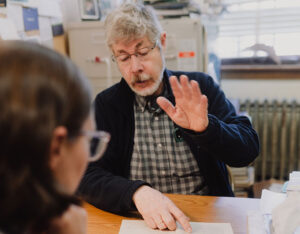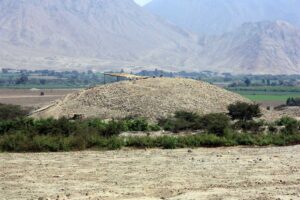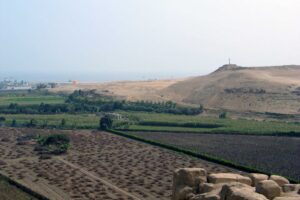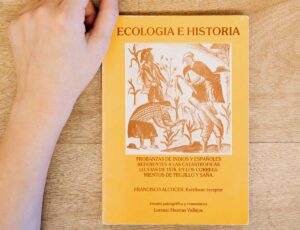Landazuri helps translate the first recorded accounts of El Niño
Examining history can reveal some of the same problems faced today, along with how to cope with them. On the northern coast of Peru, a hot spot for El Niño events, Andean indigenous groups adapted for thousands of years through methods like cycling farming to higher ground. Some of these agricultural methods were previously revealed by translating part of a survey conducted by Francsico de Alcocer, an inspector sent by the Spanish (who were colonizing the area at the time) to record eye-witness accounts after a devastating El Niño event in 1578.
Only half of the document is preserved but there still remains much to be translated and analyzed. This July, the project will resume with new life, in the hands of climate science graduate student Heather Landazuri, who is tasked with translating the entire document from 16th century Spanish to English.

Dan Sandweiss, professor of anthropology and Quaternary and climate studies, recently received support through a McGillicuddy Humanities Center grant to build on his earlier research into the Alcocer’s documents which took place in the early 1990s with then anthropology student, Wendy Copson. Sandweiss and Landazuri are now collaborating on the project.
The approximately 300-page document is a complex social and cultural record of the divide between the Spanish and native populations. “At the time the indigenous population was relocated to what I would consider kind of like a reservation, they’re called ‘reducciones,’ centralized settlements where they lived and worked to pay tribute to their Spanish lords,” explains Landazuri.
In 1580, two years after the El Niño event, the native population asked for relief from tribute payment to recover from the disaster. But the Spanish wanted to rebuild infrastructure that would benefit the production of crops like cotton and corn, which were valuable for the Spanish. “It almost plays out like a struggle between a labor union and a big corporation,” says Landazuri.
Alcocer conducted two questionnaires, one for Spanish lords, the ‘encomenderos,’ and one for native lords, the ‘caciques,’ resulting in biased survey results. “They ask essentially the same questions, but they ask them very differently,” describes Sandweiss. “For the native lords, the questions are fairly neutral: ‘What did you lose? How did you respond? What got washed away? They were straightforward questions. The questions for the Spanish lords were things like: ‘Is it not true that these natives are just lazy and don’t want to rebuild, that they don’t want to do the work?’”

Spanish failure to learn from the indigenous population prevented them from adapting to their environment during an El Niño event. The native population knew that living in the path of the floods was a bad idea and they understood that continuing to grow in floodways would be fruitless until the event was over. They would rather rebuild their local communities to recover from the disaster and possibly plant above the floodplain. “A priest who was a witness for one of the native Lords, recounts how natives told him that the fields had rotted away from the rain, they replanted and the fields rotted again. They replanted again and there was a plague of mice that were as big as medium-sized rabbits,” says Sandweiss. “He didn’t believe it, so he went out in the fields and saw piles of hundreds of dead giant mice in the fields.”
The document reveals migration patterns and even relocation, as indigenous populations moved as far north as Quito, Ecuador and as far south as Lima, as well as into the Peruvian highlands. People also changed their diets, a topic of specific interest to Landazuri who is also studying changes to marine bird populations during El Niño events. “We expect to see an abundance of rainfall, flooding, landslides, those kinds of big changes [in the document]. I hope that there’s some sort of allusion to what it looks like out on the beach,” says Landazuri. “Are there tons of birds or are the birds mysteriously gone? Is there any kind of discussion about the fishing being poor at this time?”

During periods of famine, people were forced to eat lizards, grasses, and foraged foods to survive. “Muscovy duck is an important indigenous domestic bird that was also eaten. Are there more of those being eaten than marine birds?” asks Landazuri. “Is there more reliance on European import than on what’s locally around?” Interpreting the responses is a balancing act between determining what was colonialism and what was a loss of resources due to the El Niño event.
Local expert Oswaldo Chozo Capuñay has worked with Sandweiss in the Lambayeque Valley of Túcume, where the most number of the eye-witness accounts are recorded, and has lived through three major El Niños in that valley. He will ask traditional farmers in Peru how they have responded to these events. What he observes about their responses today, will help trace methods back in time. “Heather’s going to be translating the whole thing. And then together we’ll be working on what these coping strategies are, how they fit in, which ones we can see archeologically from pre-Colombian times to make the link stronger,” said Sandweiss. The team is truly interdisciplinary, combining Climate Science and Anthropology to uncover and analyze what witnesses might have to say in the document.

Because Alcocer’s survey was ultimately meant for the Spanish Crown, the indigenous perspective is not given justice through them. “It’s primarily one-sided, it’s not as expansive as one would hope, but in between, you can find something,” says Landazuri. Sandweiss concurs, Alcocer’s survey is, among other things, “a document of the failure of Spanish colonial policy. And the failure is built around not listening to indigenous knowledge. That’s clear,” says Sandweiss. “If [the Spanish] had talked to people and taken them seriously, they would not have placed the ‘reducción’ settlements where they did. Clearly, they would not have had to send somebody up there to find out what went on if they had paid attention. It would not have been as devastating.”
Despite the social and cultural divide between the Spanish and native populations, observations can be read about ecological and environmental aspects at the time. “Archival documents can be a powerful way to learn about past weather patterns,” says Landazuri. “It reminds everyone that these are extremely important sources for more than just the one thing, or more than just telling one story about a labor uprising and requests for aid, imperialism and colonialism—there’s more to it than that. We can look at resilience. We can look at environmental change. We can look at coping.” The team hopes to publish some of their new findings by next year.

